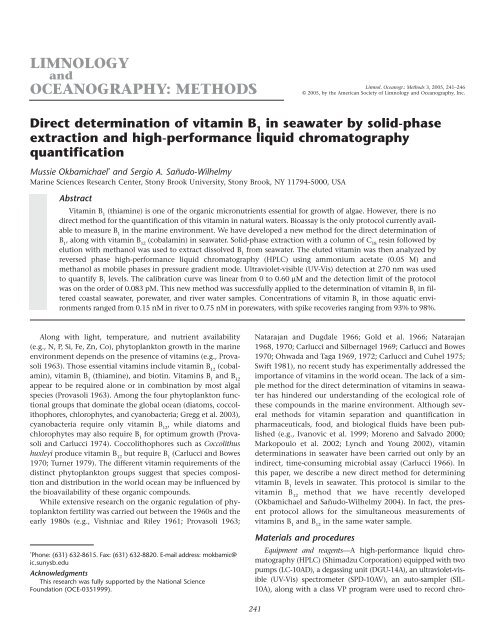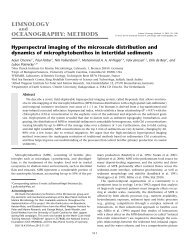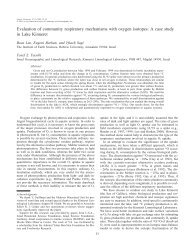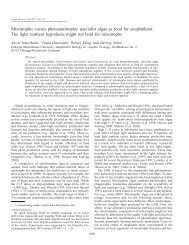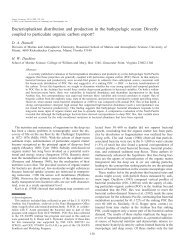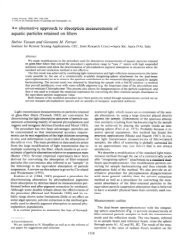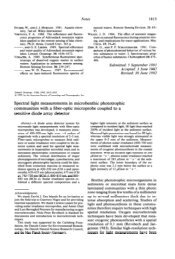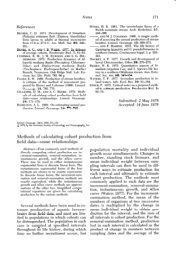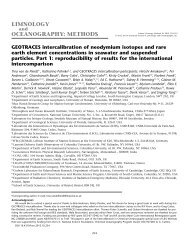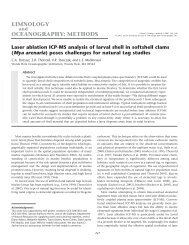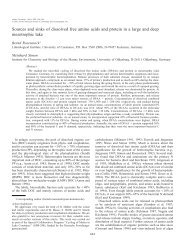Mussie Okbamichael and Sergio A. Sañudo-Wilhelmy. Direct ... - ASLO
Mussie Okbamichael and Sergio A. Sañudo-Wilhelmy. Direct ... - ASLO
Mussie Okbamichael and Sergio A. Sañudo-Wilhelmy. Direct ... - ASLO
Create successful ePaper yourself
Turn your PDF publications into a flip-book with our unique Google optimized e-Paper software.
LIMNOLOGY<br />
<strong>and</strong><br />
OCEANOGRAPHY: METHODS<br />
<strong>Direct</strong> determination of vitamin B 1 in seawater by solid-phase<br />
extraction <strong>and</strong> high-performance liquid chromatography<br />
quantification<br />
<strong>Mussie</strong> <strong>Okbamichael</strong> * <strong>and</strong> <strong>Sergio</strong> A. <strong>Sañudo</strong>-<strong>Wilhelmy</strong><br />
Marine Sciences Research Center, Stony Brook University, Stony Brook, NY 11794-5000, USA<br />
Abstract<br />
Vitamin B (thiamine) is one of the organic micronutrients essential for growth of algae. However, there is no<br />
1<br />
direct method for the quantification of this vitamin in natural waters. Bioassay is the only protocol currently available<br />
to measure B in the marine environment. We have developed a new method for the direct determination of<br />
1<br />
B , along with vitamin B (cobalamin) in seawater. Solid-phase extraction with a column of C resin followed by<br />
1 12 18<br />
elution with methanol was used to extract dissolved B from seawater. The eluted vitamin was then analyzed by<br />
1<br />
reversed phase high-performance liquid chromatography (HPLC) using ammonium acetate (0.05 M) <strong>and</strong><br />
methanol as mobile phases in pressure gradient mode. Ultraviolet-visible (UV-Vis) detection at 270 nm was used<br />
to quantify B levels. The calibration curve was linear from 0 to 0.60 µM <strong>and</strong> the detection limit of the protocol<br />
1<br />
was on the order of 0.083 pM. This new method was successfully applied to the determination of vitamin B in fil-<br />
1<br />
tered coastal seawater, porewater, <strong>and</strong> river water samples. Concentrations of vitamin B in those aquatic envi-<br />
1<br />
ronments ranged from 0.15 nM in river to 0.75 nM in porewaters, with spike recoveries ranging from 93% to 98%.<br />
Along with light, temperature, <strong>and</strong> nutrient availability<br />
(e.g., N, P, Si, Fe, Zn, Co), phytoplankton growth in the marine<br />
environment depends on the presence of vitamins (e.g., Provasoli<br />
1963). Those essential vitamins include vitamin B 12 (cobalamin),<br />
vitamin B 1 (thiamine), <strong>and</strong> biotin. Vitamins B 1 <strong>and</strong> B 12<br />
appear to be required alone or in combination by most algal<br />
species (Provasoli 1963). Among the four phytoplankton functional<br />
groups that dominate the global ocean (diatoms, coccolithophores,<br />
chlorophytes, <strong>and</strong> cyanobacteria; Gregg et al. 2003),<br />
cyanobacteria require only vitamin B 12 , while diatoms <strong>and</strong><br />
chlorophytes may also require B 1 for optimum growth (Provasoli<br />
<strong>and</strong> Carlucci 1974). Coccolithophores such as Coccolithus<br />
huxleyi produce vitamin B 12 but require B 1 (Carlucci <strong>and</strong> Bowes<br />
1970; Turner 1979). The different vitamin requirements of the<br />
distinct phytoplankton groups suggest that species composition<br />
<strong>and</strong> distribution in the world ocean may be influenced by<br />
the bioavailability of these organic compounds.<br />
While extensive research on the organic regulation of phytoplankton<br />
fertility was carried out between the 1960s <strong>and</strong> the<br />
early 1980s (e.g., Vishniac <strong>and</strong> Riley 1961; Provasoli 1963;<br />
* Phone: (631) 632-8615. Fax: (631) 632-8820. E-mail address: mokbamic@<br />
ic.sunysb.edu<br />
Acknowledgments<br />
This research was fully supported by the National Science<br />
Foundation (OCE-0351999).<br />
Natarajan <strong>and</strong> Dugdale 1966; Gold et al. 1966; Natarajan<br />
1968, 1970; Carlucci <strong>and</strong> Silbernagel 1969; Carlucci <strong>and</strong> Bowes<br />
1970; Ohwada <strong>and</strong> Taga 1969, 1972; Carlucci <strong>and</strong> Cuhel 1975;<br />
Swift 1981), no recent study has experimentally addressed the<br />
importance of vitamins in the world ocean. The lack of a simple<br />
method for the direct determination of vitamins in seawater<br />
has hindered our underst<strong>and</strong>ing of the ecological role of<br />
these compounds in the marine environment. Although several<br />
methods for vitamin separation <strong>and</strong> quantification in<br />
pharmaceuticals, food, <strong>and</strong> biological fluids have been published<br />
(e.g., Ivanovic et al. 1999; Moreno <strong>and</strong> Salvado 2000;<br />
Markopoulo et al. 2002; Lynch <strong>and</strong> Young 2002), vitamin<br />
determinations in seawater have been carried out only by an<br />
indirect, time-consuming microbial assay (Carlucci 1966). In<br />
this paper, we describe a new direct method for determining<br />
vitamin B 1 levels in seawater. This protocol is similar to the<br />
vitamin B 12 method that we have recently developed<br />
(<strong>Okbamichael</strong> <strong>and</strong> <strong>Sañudo</strong>-<strong>Wilhelmy</strong> 2004). In fact, the present<br />
protocol allows for the simultaneous measurements of<br />
vitamins B 1 <strong>and</strong> B 12 in the same water sample.<br />
Materials <strong>and</strong> procedures<br />
Equipment <strong>and</strong> reagents—A high-performance liquid chromatography<br />
(HPLC) (Shimadzu Corporation) equipped with two<br />
pumps (LC-10AD), a degassing unit (DGU-14A), an ultraviolet-visible<br />
(UV-Vis) spectrometer (SPD-10AV), an auto-sampler (SIL-<br />
10A), along with a class VP program were used to record chro-<br />
241<br />
Limnol. Oceanogr.: Methods 3, 2005, 241–246<br />
© 2005, by the American Society of Limnology <strong>and</strong> Oceanography, Inc.
<strong>Okbamichael</strong> <strong>and</strong> <strong>Sañudo</strong>-<strong>Wilhelmy</strong> Determination of vitamin B 1 in seawater<br />
matographs <strong>and</strong> calculate peak heights of vitamin B 1 . The HPLC<br />
column used was a reversed-phase Premier C 18 (150 × 4.6 mm, 5 µm)<br />
from Shimadzu. High-purity water obtained through a Milli-Q<br />
purification system was used in all procedures. HPLC grade<br />
methanol <strong>and</strong> ammonium acetate were obtained from Fisher<br />
Scientific. Vitamin B 1 st<strong>and</strong>ard was obtained from Alexis Biochemicals.<br />
Polypropylene columns with porous polyethylene<br />
support used in the solid-phase extractions were available from<br />
Bio-Rad Lab <strong>and</strong> the 17% High Capacity C 18 resin (HF Bondesil;<br />
120 µm) was obtained from Varian Inc.<br />
Solid-phase extraction protocol—Vitamin B 1 was extracted from<br />
seawater following the procedures developed for the solid-phase<br />
extraction of vitamin B 12 (<strong>Okbamichael</strong> <strong>and</strong> <strong>Sañudo</strong>-<strong>Wilhelmy</strong><br />
2004). A preconcentration system was set up using a peristaltic<br />
pump with rotor heads (Cole-Parmer, Masterflex, Model 7553-12,<br />
1-100 rpm), polypropylene preconcentration columns <strong>and</strong> Teflon<br />
tubing that extended from the head of the column into the bottom<br />
of a 2 L polycarbonate bottle reservoir. The set-up was<br />
designed to process four samples simultaneously, using four peristaltic<br />
heads per pump. About 5 mL of the C 18 resin was cleaned<br />
<strong>and</strong> conditioned by immersing it in 10 mL methanol (100%) that<br />
formed a cloudy suspension (slurry). The slurry of C 18 resin was<br />
loaded into the column, left st<strong>and</strong>ing for about 1 h to elute the<br />
methanol <strong>and</strong> then washed with 20 mL of Milli-Q water. The pH<br />
of the filtered (
<strong>Okbamichael</strong> <strong>and</strong> <strong>Sañudo</strong>-<strong>Wilhelmy</strong> Determination of vitamin B 1 in seawater<br />
A<br />
B<br />
Fig. 1. HPLC chromatograms of vitamin B 1 (λ = 270 nm; retention time ~4 min). (A) B 1 st<strong>and</strong>ard in Milli-Q water (0.59 nM) <strong>and</strong> (B-D) in seawater containing<br />
0.18 nM of the vitamin <strong>and</strong> spiked with different levels of B 1 (0.074, 0.15, <strong>and</strong> 0.30 nM, respectively). As shown in Fig. 1B-D, the retention time<br />
remained the same for all the spiked samples <strong>and</strong> the instrument’s signal was linear with respect to concentration (AU = 0.14, 0.18, <strong>and</strong> 0.27 for B 1 levels of<br />
0.25, 0.33, <strong>and</strong> 0.47 nM, respectively). As confirmed by analyzing seawater devoid of B 1 (rendered vitamin free by passing it through the C 18 resin), the baseline<br />
drift observed in the chromatograms was caused by seawater background absorbance <strong>and</strong>, hence, it was accounted for in peak height estimations.<br />
During the solid phase extraction, the maximum recovery<br />
of B 1 (96% to 98%) was obtained within a pH range between<br />
6.1 <strong>and</strong> 6.7, <strong>and</strong> a sample flow rate of 1 mL min –1 . The effect<br />
of the pH on the recovery of B 1 may be attributed to solventexchange<br />
reactions in the seawater sample, the C 18 resin, <strong>and</strong><br />
the methanol, as pH affects the ionic strength of the medium<br />
(Stumm <strong>and</strong> Morgan 1996) <strong>and</strong> the surface characteristics of<br />
the C 18 resin. The effect of the flow rate on the extraction yield<br />
suggests that the lower the flow rate, the longer the contact<br />
time that is available for the exchange reaction between the<br />
vitamin <strong>and</strong> the resin. More than 99% of B 1 was recovered<br />
with the first three 5-mL aliquots of methanol during the elution<br />
of the solid-phase extraction.<br />
As there is no st<strong>and</strong>ard reference material for vitamin B 1 in<br />
seawater, spike experiments were carried out to test the recovery<br />
C<br />
D<br />
of the current method. Different concentrations of B 1 (0.074,<br />
0.15, <strong>and</strong> 0.30 nM) were added to filtered seawater samples with<br />
known initial B 1 levels from Stony Brook Harbor channel <strong>and</strong><br />
the Peconic River. The recovery of B 1 in those spiked samples<br />
ranged from 93% to 98% (Table 1). Furthermore, a 96% ± 1%<br />
recovery was obtained in dried methanol aliquots stored frozen<br />
for 2 mo <strong>and</strong> redissolved in 1 mL of Milli-Q water, whereas only<br />
76% ± 2% was recovered when the dried aliquots were stored<br />
refrigerated (Table 1). This is crucial for the measurement of B 1<br />
in the open ocean, where samples are collected during oceanographic<br />
cruises that may last several months, <strong>and</strong> where it is<br />
impractical to store large numbers of frozen samples. Because B 1<br />
is stable from pH 2 to 4 (Kawasaki <strong>and</strong> Sanemori 1985), samples<br />
may be preserved by acidification. However, further studies<br />
need to evaluate that preservation option.<br />
243
<strong>Okbamichael</strong> <strong>and</strong> <strong>Sañudo</strong>-<strong>Wilhelmy</strong> Determination of vitamin B 1 in seawater<br />
Fig. 2. Calibration curve for vitamin B 1 . Linearity was established using the<br />
least squares method in st<strong>and</strong>ard concentration ranges of 0 to 0.60 µM.<br />
The general protocol for the analysis of B 1 in seawater can<br />
be summarized as follows: collection of filtered water, pH<br />
adjustment of the water sample to be analyzed (between 6.1<br />
<strong>and</strong> 6.7), loading of the sample onto 5 mL C 18 resin at a flow<br />
rate of 1 mL min –1 , rinsing of the C 18 resin before sampleelution<br />
with 20 mL of Milli-Q water, B 1 elution with three<br />
aliquots of 5 mL methanol each, volatizing 1 mL of each 5 mL<br />
eluent to dryness with nitrogen, redissolving the B 1 extracted<br />
in 1 mL Milli-Q water, <strong>and</strong> HPLC detection at 270 nm. Determination<br />
of ambient B 1 at concentrations lower than those<br />
measured here could presumably be attained by preconcentrating<br />
higher volumes of seawater on the C 18 resin. Therefore,<br />
the preconcentration using solid phase extraction renders the<br />
method applicable to detect almost any levels of B 1 in natural<br />
waters. Additional concentration factors could also be attained<br />
by redissolving the dried methanol aliquots in less than 1 mL<br />
Milli-Q water, as only 40 µL is injected into the HPLC, or by<br />
drying more than 1 mL of the eluent. Similarly, lower sample<br />
volumes could be used in environments where vitamin levels<br />
are expected to be higher. For example, we measured 0.31 nM of<br />
B 1 in a 1-L sample collected from the Peconic River <strong>and</strong> 0.75 nM<br />
in 100 mL porewater extracted from Flax Pond, New York.<br />
Application of the method to natural waters—Concentrations<br />
of vitamin B 1 in coastal <strong>and</strong> river water samples ranged from<br />
0.23 to 0.31 nM (Table 1). The higher concentrations of B 1 were<br />
measured in samples from the Peconic River (0.31 ± 0.01 nM;<br />
mean ± 1 st<strong>and</strong>ard deviation) <strong>and</strong> seawater from Stony Brook<br />
244<br />
Table 1. Concentrations of vitamins B 1 <strong>and</strong> B 12 in surface waters<br />
collected in Stony Brook Harbor channel in January (SBHC-Jan)<br />
<strong>and</strong> April 2004 (SBHC-Apr), <strong>and</strong> in the Peconic River (PeconicR-Apr)<br />
in April 2004<br />
Sample B (nM) 1 B (nM) 12<br />
Recovery<br />
(%)<br />
SBHC-Jan 0.294 ± 0.009 0.048 ± 0.001 95-98<br />
SBHC-Jan + 100 0.579 ± 0.010 0.119 ± 0.003<br />
SBHC-Apr 0.233 ± 0.005 0.050 ± 0.002 93-98<br />
SBHC-Apr + 50 0.382 ± 0.010 0.084 ± 0.002<br />
PeconicR-Apr 0.308 ± 0.009 0.053 ± 0.001 93-97<br />
PeconicR-Apr + 25 0.367 ± 0.004 0.071 ± 0.002<br />
Frozen 0.285 ± 0.004 0.073 ± 0.001 93-97<br />
Refrigerated 0.227 ± 0.008 0.056 ± 0.002 74-78<br />
They were spiked with 0.074 (PeconicR-Apr + 25), 0.15 (SBHC-Apr + 50),<br />
<strong>and</strong> 0.30 nM (SBHC-Jan + 100). The recovery of the simultaneous analysis<br />
of vitamins B <strong>and</strong> B in the spiked samples ranged from 93% to 98%.<br />
1 12<br />
Included are concentration of vitamin B <strong>and</strong> B in seawater from Stony<br />
1 12<br />
Brook Harbor channel analyzed after being dried <strong>and</strong> stored for 60 d refrigerated<br />
<strong>and</strong> frozen. The similar levels of B <strong>and</strong> B measured before <strong>and</strong><br />
1 12<br />
after freezing (93%-97%) indicated that water samples can be preserved<br />
by drying <strong>and</strong> freezing for 2 mo without significant losses of B <strong>and</strong> B ,<br />
1 12<br />
whereas refrigeration yields lower recoveries (74%-78%).<br />
Harbor channel collected in January 2004 (0.29 ± 0.01 nM).<br />
Lower levels were detected at the tidal channel of Stony Brook<br />
Harbor during April 2004 (0.23 ± 0.01 nM). These results were<br />
consistent with the characteristics of the sampling sites <strong>and</strong> the<br />
sampling time. For example, the high concentration of B 1 in<br />
the shallow (0.5 m), stagnant Peconic River can likely be attributed<br />
to the high bacterial activity observed in that environment<br />
(Breuer et al. 1999). This is consistent with the bacterial<br />
production of vitamin B 1 (Burkholder <strong>and</strong> Burkholder 1956;<br />
Provasoli 1963). Furthermore, our sediment resuspension<br />
experiments indicated that sediments are an important source<br />
of B 1 in shallow environments (see following section).<br />
The concentration of vitamin B 1 measured at the channel<br />
of Stony Brook Harbor in January was higher than that measured<br />
in April (Table 1). This could be the result of the higher<br />
biological uptake of this vitamin by phytoplankton during the<br />
spring bloom. This temporal trend is consistent with decreasing<br />
vitamin B 1 concentrations from winter to spring reported<br />
for the Gulf of Maine (Swift 1981).<br />
Stability of vitamin B 1 in seawater—We carried out a series of<br />
laboratory incubation experiments to establish the stability of<br />
B 1 in seawater, as this vitamin is unstable at alkaline pH<br />
(Jansen 1972). In these laboratory experiments, levels of B 1<br />
were measured at the beginning of the experiment <strong>and</strong> at 6,<br />
12, 24, <strong>and</strong> 48 h in seawater of slightly alkaline pH (7.5) collected<br />
at Stony Brook Channel <strong>and</strong> incubated at room temperature<br />
(Fig. 3). Those results showed that about 70% of the<br />
initial B 1 concentration was hydrolyzed within 6 h. By 12 h,<br />
most of the vitamin (90%) was decomposed. As the incubated<br />
seawater was not filtered, biological uptake of B 1 could not be
<strong>Okbamichael</strong> <strong>and</strong> <strong>Sañudo</strong>-<strong>Wilhelmy</strong> Determination of vitamin B 1 in seawater<br />
Fig. 3. Concentrations of B 1 in porewater, surface seawater, <strong>and</strong> sedimentoverlying<br />
seawater under light <strong>and</strong> dark conditions. In each treatment (light<br />
<strong>and</strong> dark conditions), about 300 g of freshly collected sediments were<br />
added to polycarbonate containers filled with 0.2 µm filtered seawater <strong>and</strong><br />
incubated for 48 h at room temperature. Sub-samples of 500 mL each were<br />
collected at the beginning of the experiment <strong>and</strong> at 6, 12, 24, <strong>and</strong> 48 h<br />
from each treatment. At each time of subsampling, sediments were resuspended<br />
by manual shaking <strong>and</strong> the water sample was filtered. The results<br />
of these experiments were compared against seawater controls. Porewater<br />
from the sediments used in the laboratory incubations was also extracted<br />
by centrifugation <strong>and</strong> analyzed for B 1 using our new protocol.<br />
ruled out. However, these results are consistent with those<br />
reported by Gold et al. (1966) showing that about 80% of B 1<br />
in seawater was destroyed within 12 h.<br />
The lability of B 1 is also suggested by our laboratory results<br />
of seawater (pH ~7.8) spiked with Flax Pond sediments <strong>and</strong><br />
incubated under light <strong>and</strong> dark conditions (Fig. 3). In those<br />
experiments, between 85% <strong>and</strong> 92% of the vitamin was also<br />
removed within 12 h, most likely due to alkaline hydrolysis<br />
<strong>and</strong>/or biological uptake. The slight difference in the levels of<br />
B 1 (10%-15%) measured in samples incubated under light <strong>and</strong><br />
dark conditions suggests that the effect of light on the decomposition<br />
of this vitamin may not be highly significant (Fig. 3).<br />
The importance of sediment resuspension on B 1 levels in<br />
coastal environments was also studied by measuring dissolved B 1<br />
in our sediment addition treatments (Fig. 3). The concentration<br />
gradient between porewater (0.75 nM) <strong>and</strong> seawater (0.18 nM)<br />
Fig. 4. Simultaneous determination of vitamins B 1 <strong>and</strong> B 12 in surface<br />
waters of the Peconic river estuary <strong>and</strong> Stony Brook Harbor.<br />
suggests a strong diffusive flux from the sediments to the water<br />
column. Furthermore, the significant increase in B 1 levels (50%<br />
to 60%) after shaking the incubation chambers containing sediments<br />
suggests that sediment resuspension events are likely to<br />
influence the level of this vitamin in shallow waters.<br />
Simultaneous determination of vitamins B 1 <strong>and</strong> B 12 in seawater—Dissolved<br />
water samples collected in the Peconic River<br />
estuary <strong>and</strong> Stony Brook Harbor were analyzed for vitamins<br />
B 1 <strong>and</strong> B 12 (Fig. 4). The simultaneous determination of both<br />
vitamins is feasible because the sampling, storage, <strong>and</strong> preconcentration<br />
protocols for B 1 <strong>and</strong> B 12 are the same; the only<br />
difference is that B 1 quantification in the HPLC is carried out<br />
at a wavelength of 270 nm while B 12 is detected at 362 nm<br />
(<strong>Okbamichael</strong> <strong>and</strong> <strong>Sañudo</strong>-<strong>Wilhelmy</strong> 2004).<br />
The recovery of B 1 <strong>and</strong> B 12 in spiked seawater from Stony<br />
Brook Harbor <strong>and</strong> the Peconic River analyzed simultaneously<br />
was excellent (93% to 98%; Table 1). The significant linear correlation<br />
between B 1 <strong>and</strong> B 12 levels (r 2 = 0.78, P < 0.05) observed<br />
in the different environments sampled during this study suggests<br />
a similar biogeochemical behavior of both vitamins in<br />
the aquatic environment. The non-zero intercept is consistent<br />
with the higher stability of B 12 with respect to B 1 at the ambient<br />
pH in the aquatic environment ranging from 5 to 8<br />
(Kawasaki <strong>and</strong> Sanemori 1985; Lindemans <strong>and</strong> Abels 1985).<br />
In summary, we have developed a direct method for the<br />
determination of vitamin B 1 in seawater. This new protocol<br />
involves a solid-phase extraction technique for separation <strong>and</strong><br />
preconcentration of the vitamin. Gradient elution with UV-Vis<br />
245
<strong>Okbamichael</strong> <strong>and</strong> <strong>Sañudo</strong>-<strong>Wilhelmy</strong> Determination of vitamin B 1 in seawater<br />
detection using reversed phase HPLC was used to quantify vitamin<br />
B 1 in seawater. This method is sensitive, simple, <strong>and</strong> accurate<br />
<strong>and</strong> provides the first direct quantification of B 1 in seawater.<br />
The technique was successfully applied to the determination of<br />
B 1 along with vitamin B 12 in coastal seawater, porewater, <strong>and</strong><br />
river water samples from around Long Isl<strong>and</strong>, New York. This<br />
new method can be employed as a routine analytical tool for the<br />
accurate determination of dissolved vitamins B 1 <strong>and</strong> B 12 in seawater,<br />
which is essential for underst<strong>and</strong>ing the cycling <strong>and</strong> ecological<br />
roles of those vitamins in the marine environment.<br />
References<br />
Breuer, E., S. A. <strong>Sañudo</strong>-<strong>Wilhelmy</strong>, <strong>and</strong> R. C. Aller. 1999. Trace<br />
metals <strong>and</strong> dissolved organic carbon in an estuary with<br />
restricted river flow <strong>and</strong> brown tide bloom. Estuaries 22:<br />
603-615.<br />
Burkholder, P. R., <strong>and</strong> L. M. Burkholder. 1956. Vitamin B in 12<br />
suspended solids <strong>and</strong> marsh muds collected along the coast<br />
of Georgia. Limnol. Oceanogr. 1:202-208.<br />
Carlucci, A. F. 1966. Bioassay of seawater. II. Methods for the<br />
determination of vitamin B in seawater. Can. J. Microbiol.<br />
1<br />
12:1079-1089.<br />
——— <strong>and</strong> R. L. Cuhel. 1975. Vitamins in South Polar Seas. I.<br />
Distribution <strong>and</strong> significance of dissolved <strong>and</strong> particulate<br />
vitamin B , thiamine <strong>and</strong> biotin in the Southern Indian<br />
12<br />
Ocean, p. 115-128. In G. A. Llano [Ed.], Adaptations within<br />
Antarctic ecosystems: Proceedings of the third SCAR symposium<br />
on Antarctic Biology. Gulf Printing Co.<br />
——— <strong>and</strong> S. B. Silbernagel. 1969. Effect of vitamin concentrations<br />
on growth <strong>and</strong> development of vitamin-requiring<br />
algae. J. Phycol. 5:64-67.<br />
——— <strong>and</strong> P. M. Bowes. 1970. Production of vitamin B , thi- 12<br />
amine, <strong>and</strong> biotin by phytoplankton. J. Phycol. 6:351-357.<br />
Gold, K., O. A. Roels, <strong>and</strong> H. Bank. 1966. Temperature dependent<br />
destruction of thiamine in seawater. Limnol. Oceanogr.<br />
12:410-413.<br />
Gregg, W. W., P. Ginoux, P. S. Schopf, <strong>and</strong> N. W. Casey. 2003.<br />
Phytoplankton <strong>and</strong> iron: validation of a global threedimensional<br />
ocean biogeochemical model. Deep Sea Res. II<br />
50:3143-3169.<br />
Jeffrey, S. W., H. S. MacTavish, W. C. Dunlap, M. Vesk, <strong>and</strong><br />
K. Groenewoud. 1999. Occurrence of UVA- <strong>and</strong> UVBabsorbing<br />
compounds in 152 species (206 strains) of<br />
marine microalgae. Mar. Ecol. Prog. Ser. 189:35-51.<br />
Ivanovic, D., A. Popovic, D. Radulovic, <strong>and</strong> M. Medenica.<br />
1999. Reversed-phase ion-pair HPLC determination of<br />
some water-soluble vitamins in pharmaceuticals. J. Pharm.<br />
Biomed. Anal. 18:999-1004.<br />
Jansen, B. C. P. 1972. Thiamine, p 99. In W. H. Sebrell<br />
<strong>and</strong> R. S. Harris [Eds.], The vitamins, Vol. 5, Academic<br />
Press.<br />
Kawasaki, T. <strong>and</strong> H. Sanemori. 1985. Vitamin B : Thiamines, p.<br />
1<br />
385-411. In A. P. De Leenheer, W. E. Lambert, <strong>and</strong> M. G. M.<br />
De Ruyter [Eds.], Modern chromatographic analysis of the<br />
246<br />
vitamins. Marcel Dekker Inc.<br />
Lindemans, J., <strong>and</strong> J. Abels. 1985. Vitamin B <strong>and</strong> related cor-<br />
12<br />
rinoids, p. 497-539. In A. P. De Leenheer, W. E. Lambert,<br />
M. G. M. De Ruyter [Eds.], Modern chromatographic analysis<br />
of the vitamins. Marcel Dekker Inc.<br />
Lynch, P. L., <strong>and</strong> I. S. Young. 2000. Determination of thiamine<br />
by high performance liquid chromatography. J. Chromatogr.<br />
A 881:267-284.<br />
Markopoulo, C. K., K. A. Kagkadis, <strong>and</strong> J. E. Koundourellis.<br />
2002. An optimized method for the simultaneous determination<br />
of vitamins B , B , B in multivitamin tablets by<br />
1 6 12<br />
high performance liquid chromatography. J. Pharm. Biomed.<br />
Anal. 30:1403-1410.<br />
Moreno, P., <strong>and</strong> V. Salvado. 2000. Determination of eight water<br />
<strong>and</strong> fat soluble vitamins in multi-vitamin pharmaceutical<br />
formulations by HPLC. J. Chromatogr. A 870:207-215.<br />
Natarajan, K. V. 1968. Distribution of thiamine, biotin, <strong>and</strong><br />
niacin in the sea. Appl. Microbiol. 16:366-369.<br />
———. 1970. Distribution <strong>and</strong> significance of vitamin B <strong>and</strong> 12<br />
thiamine in the Subarctic Pacific Ocean. Limnol. Oceanogr.<br />
15:655-659.<br />
——— <strong>and</strong> R. C. Dugdale. 1966. Bioassay <strong>and</strong> distribution of<br />
thiamine in the sea. Limnol. Oceanogr. 11: 621-629.<br />
Ohwada, K., <strong>and</strong> N. Taga. 1969. Distribution of vitamin B , 12<br />
thiamine <strong>and</strong> biotin in marine sediments. J. Oceanogr. Soc.<br />
Japan 25:123-136.<br />
——— <strong>and</strong> ———. 1972. Distribution <strong>and</strong> seasonal variation<br />
of vitamin B , thiamine <strong>and</strong> biotin in the sea. Mar. Chem.<br />
12<br />
1:61-73.<br />
<strong>Okbamichael</strong>, M., <strong>and</strong> S. A. <strong>Sañudo</strong>-<strong>Wilhelmy</strong>. 2004. New<br />
method for the determination of vitamin B in seawater.<br />
12<br />
Anal. Chim. Acta 517:33-38.<br />
Provasoli, L. 1963. Organic regulation of phytoplankton fertility,<br />
p. 165-219. In M. N. Hill [Ed.], The sea, Vol. 2, Interscience.<br />
——— <strong>and</strong> A. F. Carlucci. 1974. Vitamins <strong>and</strong> growth regulators,<br />
p. 741-787. In W. D. P. Stewart [Ed.], Algal physiology<br />
<strong>and</strong> biochemistry, Blackwell Scientific.<br />
Stumm, W., <strong>and</strong> J. J. Morgan. 1996. Aquatic chemistry:<br />
Chemical equilibria <strong>and</strong> rates in natural waters (3rd ed.),<br />
Wiley.<br />
Swift, D. G. 1981. Vitamin levels in the Gulf of Maine <strong>and</strong> ecological<br />
significance of vitamin B there. J. Mar. Res. 39:<br />
12<br />
375-403.<br />
Turner, M. F. 1979. Nutrition of some marine micro algae with<br />
special reference to vitamin requirements <strong>and</strong> utilization of<br />
nitrogen <strong>and</strong> carbon sources. J. Mar. Biol. Assoc. U.K. 59:<br />
535-552.<br />
Vishniac, H. S., <strong>and</strong> G. A. Riley. 1961. Cobalamin <strong>and</strong> thiamine<br />
in Long Isl<strong>and</strong> Sound: patterns of distribution <strong>and</strong><br />
ecological significance. Limnol. Oceanogr. 6:36-41.<br />
Submitted 31 July 2004<br />
Revised 18 February 2005<br />
Accepted 20 April 2005


